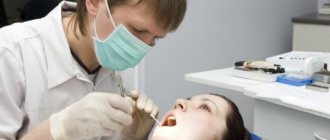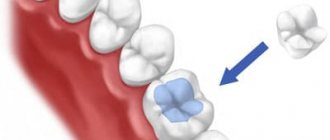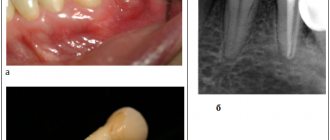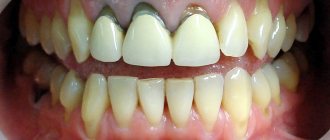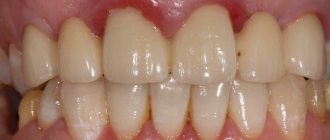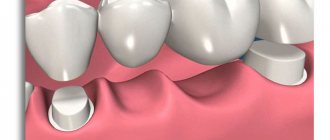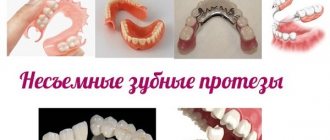Chief editor of the site:
Snitkovsky Arkady Alexandrovich
Chief physician of the professorial dentistry “22 Century”, dentist, orthopedic dentist
Author of the article:
Scientific team of dentistry “22 Century”
Dentists, candidates and doctors of medical sciences, professors
Materials and production of crowns
Artificial crowns are permanent prostheses in the form of caps that restore the anatomical shape of the tooth, chewing and aesthetic functions of severely damaged hard dental tissues. When they are manufactured in a dental laboratory, various materials or combinations thereof are used. They have a long history of use in dentistry: the first mentions date back to the 18th century.
Classification:
By purpose:
- Restorative;
- Abutment (used in bridges ; they replace not only a defect within the coronal part of a tooth, but also a missing tooth or several teeth).
By design features:
- Full (cover the prepared stump from all sides), partial (three-quarter, half-crowns) leave the outer surface of the crown open;
- Telescopic (double; used in removable prosthetics, the first cone-shaped is fixed on the stump, the second, restoring the tooth, is part of the removable part and is put on the first).
According to the material used:
- Metal (noble or base alloys);
- Non-metallic (ceramics, zirconium dioxide, plastic, composite);
- Combined (metal-ceramics, metal-plastic).
By fixation method:
- Cemented (for prosthetics of natural teeth or on implants);
- Screw (used only for prosthetics on implants - artificial analogues of natural roots, strengthened inside the bone tissue of the jaws).
By service life:
- Permanent;
- Temporary - provisional (used at the stages of manufacturing the final ones to protect the stump from irritants, restore contacts with other teeth and for aesthetic purposes, including to form the contour of the gums ).
What are crowns?
An artificial crown is used if a tooth is damaged, broken, changed color, or it is not possible to use a filling. With the help of such a device, you can completely restore the chewing function, acquire the aesthetic beauty of your smile, and also prevent the development of malocclusion.
If it is necessary to install an artificial crown, you need to determine whether it will serve to restore the tooth or act as a support for the installed bridge. The nature of the damage and the characteristics of the dentition are important.
Almost all types of crowns are fixed to the tooth using certain materials, forming a single structure. There is a huge selection of similar products based on material, functional purpose and cost.
The indications for the use of these structures are the broadest:
Indications for the use of crowns
- Defects of the natural crown are more than half its size;
- Increased (inappropriate for age) abrasion of teeth; correction of jaw relationship (bite);
- Deep wedge-shaped defects are areas of triangular-shaped loss of hard tissue in the neck of the tooth (near the gums), weakening it and increasing the risk of complete breakage during chewing;
- Congenital anomaly of tooth shape (for example, underdevelopment or complete absence of enamel) or acquired (for example, after injury);
- Some congenital or acquired pronounced color changes that cannot be eliminated by bleaching (discolorities) are the consequences of injuries, medications used or materials for filling root canals;
- Tilting and/or protrusion of a tooth or a group of them when the patient refuses orthodontic treatment (orthopedic “movement”);
- Combining - splinting - teeth when they are mobile (the crowns are not made separately, but as a single block and are fixed at the same time);
- The need to improve the shape and protection of the tooth during removable prosthetics (creating pronounced convex contours that will hold the fixing elements and, along with them, the prosthesis itself);
- The presence of aesthetically unsatisfactory crowns (all-metal, combined with chips of the facing material or a gray-blue border, visible at the gingival margin when it decreases or thins).
Despite the variety of clinical situations in which the use of these structures is justified, the general rule is prosthetics in the early stages.
Types by purpose
Doctors distinguish several types of artificial crowns according to their purpose. If part of a tooth is missing, a restorative structure is used. Its main purpose is to return the required anatomical shape of the tooth. If most of the teeth are missing in the oral cavity, this is compensated with the help of dentures. They require additional support, which is provided by crowns.
Removable dentures and some types of maxillofacial appliances require contour crowns. The degree of loosening of teeth at different stages of the disease can be very different. One of the treatment methods is the use of splinting crowns. They help relieve some of the load from the teeth on the side of the pathology, and slow down the process of premature loss.
Special therapeutic crowns have a good therapeutic effect. They allow you to somewhat speed up the process of formation of natural dentin. As a result, the hard part of the tooth is restored. This does not require pulp removal.
To reduce or prevent pathological wear of teeth, preventive crowns are installed. They help to slightly change the length of teeth, as well as restore their attractiveness.
During the preparation of teeth, the pulp suffers greatly, as it is exposed to various irritants. Preparation is a preparatory stage for the installation of permanent dentures. To provide protection to the pulp, crowns with artificial gum are used. They help provide better protection.
Advantages of artificial crowns:
Advantages of artificial crowns
- Increasing the physical and mechanical characteristics of the crown of a natural tooth due to the circular coverage of the dental stump with a solid structure;
- The ability to reproduce or correct the appearance of the crown in the desired direction;
- The ability to perform the function of a supporting element of a fixed or removable prosthesis.
If all conditions are met, the possible disadvantages of this design (for example, bleeding, temporary whitening or a feeling of pressure in the area of the adjacent gum) are mild or completely absent. However, it should be understood that while performing a restorative and, to a certain extent, preventive function, orthopedic treatment does not affect the main cause of caries - the acid produced by plaque microorganisms. This means that daily personal oral hygiene measures must be carried out in full.
Each type of crown is characterized by its own manufacturing technology: metal ones are cast or stamped, plastic and composite ones are polymerized, ceramic ones are sintered, pressed, milled. Those previously used (stamped with plastic lining, partial, metal-plastic) are now rarely used. Despite this circumstance, at the present stage of development there is a sufficient variety of options to find the optimal solution in each case.
The choice of material and technology depends on the objectives of the individual clinical situation.
Crown selection criteria
Each of these types of dental crowns has variations within its category (type of alloy, features of the material, production method). The quality of the final product consists of many factors that must be taken into account when choosing a product. Cost is one of the main selection criteria, but far from the most important. To choose the right material, you need to take into account the characteristics of the types of crowns on your teeth, and which ones are best suited in your case. Thus, the strength of the material for chewing teeth must be high - after all, they bear a significant load. And for the front ones, the aesthetics of the material and naturalness are important. It is necessary to take into account the parameters of the durability of the prosthesis. Modern designs are designed for a long service life - 10-15 years.
Dentures are a relatively inexpensive, aesthetic and universal method of restoration. They are popular with patients because they restore chewing and speech functions, protect against further damage, and help achieve the smile everyone dreams of. The choice of options for prosthetics is extensive, so you can find one that suits you in all respects. To choose the right type of crown for your teeth and decide which one is needed in your situation, you need to contact experienced orthodontists. Professionals have at their disposal not only a comfortable office, but also modern equipment.
If you have any questions, our dentistry in Kazan provides free consultations, and we will be happy to help you, explain everything and provide dental treatment.
Materials for making artificial crowns:
Materials for making artificial crowns
- Stainless steel (stamped);
- Alloys of gold and silver (all-metal cast);
- Cobalt-chrome, cobalt-nickel and palladium alloys (cast metal base combined or as an independent material);
- Plastics of cold (when mixing the components they harden in the oral cavity) or hot (when mixing the components they harden under heating and high pressure) polymerization (for clinical, i.e. directly in the office or laboratory production of temporary structures, respectively);
- Technical composites (temporary, laboratory-produced);
- Ceramic masses (for lining frames or making porcelain crowns);
- Zirconium dioxide (aluminum compound) is a modern standard of aesthetic prosthetics.
How to choose the right one
If there are indications for the installation of such structures, then it is necessary to take into account the requirements for artificial crowns. It is recommended to install microprostheses on the front teeth, which have very good aesthetic qualities. These include porcelain or metal-ceramic dentures.
If you need to install crowns on chewing teeth, it is best to choose cast metal structures. They have an affordable price, since their aesthetic qualities are not high enough. But such structures have a longer service life.
If you want each chewing tooth to look as natural as possible, then you can use metal-ceramic structures. Products lined with ceramic mass have optimal aesthetic qualities. In addition, it is worth noting that they have a high level of strength.
It is worth noting that it is imperative to take into account the basic requirements for artificial crowns, since it is important to provide proper care so that they last for a long time. If a ceramic type of structure is installed, then toothpaste, floss and a brush will be enough. You can also purchase special irrigators, which are characterized by the fact that a stream of water is supplied through a special nozzle.
General sequence of clinical and laboratory stages of manufacturing artificial crowns
Dental prosthetics
Several specialists take part in their creation:
- Orthopedic dentist (carries out diagnostics, design planning, consultation, preparation of teeth for prosthetics - odontopreparation, taking impressions, quality control of the construction at all stages with correction if necessary, fitting, temporary and permanent fixation, dispensary observation - periodic examinations);
- Dental technician (together with the doctor, plans the future design and carries out its direct production on models (plaster analogues of teeth and jaws, obtained from impressions) in the laboratory, makes adjustments, if any);
- Dental assistant – performs auxiliary manipulations in the oral cavity and office during treatment.
Stage 1:
- Diagnostic – basic (questioning, i.e. medical history, examination) and additional (usually one of the types of x-ray examination) examination methods, drawing up and agreeing on a treatment plan, impressions for diagnostic models and temporary crowns , preliminary determination of color, bite registration . If necessary, auxiliary measures are carried out - a complex of professional hygiene (removal of dental plaque), treatment or re-treatment of caries (replacement of old restorations), endodontic (pulp removal, re-treatment of the root canal system) or surgical (lengthening of the clinical, i.e. visible crown with insufficient height). In a difficult clinical situation, total prosthetics, a special device is used - a face bow , which fixes the position of the upper jaw in the space of the skull and makes it possible to transfer it to a device that reproduces the natural movements of the lower jaw - an articulator. A dental photography protocol is also used - registration of images of the patient’s face in front and in profile, dentition in a closed and open state in the anterior and lateral sections. This manipulation helps the technician in choosing the visual characteristics of the future restoration (building a color scheme for the restoration, determining its size and shape).
Stage 2
- Preparatory – odontopreparation – grinding of hard tissues to create the shape of the tooth stump, providing the possibility of applying and subsequent fixation of the structure, as well as ensuring the correct relationship between the edge of the crown and the soft tissues of the gums. During this manipulation on living teeth, water-air cooling in order to prevent overheating of the hard tissues of the tooth. Taking working impressions, final color determination. Fitting, correction (relining) and temporary fixation of temporary crowns.
Stage 3
- Final – delivery of the work (trying on and, if necessary, correction of the structure, agreement with the patient on the coincidence of the existing and desired results regarding color, shape, size, convenience, temporary (for combined) or permanent (for metal-free structures) fixation; subsequent replacement of the temporary fixation with a permanent one) .
How to restore your smile area
One of the difficult tasks is the restoration of the front teeth, because it must be solved as quickly as possible. It is recommended to use non-removable prosthetics. This is the only way to achieve increased stability of the crowns and get maximum benefits from use.
Dental restoration
All prosthetic methods aimed at restoration or compensation can be divided into several groups.
Color and shape
Lumineers or veneers are often used for these purposes. These are onlays, the shape of which matches the tooth, and the color is chosen by the patient. The surface may not be pre-ground.
Restoring part of a tooth
This method is used if part of the crown is destroyed by more than half. Artificial crowns are used; different materials are used for manufacturing.
First, part of the tooth is ground down, then a crown is installed. The disadvantage of this method is that during preparation it is necessary to remove most of the tooth.
Using the stump tab
Filling a gap in the dentition
To solve this problem, two methods can be used: installing implants or a bridge structure. The second option is considered the most budget-friendly, which is why it is in high demand. This is a group of crowns, attached to the supporting teeth, no grinding is needed.
With bridge prosthetics, a maximum of four teeth can be restored. All materials are suitable, with the exception of phosphorus.
Implants are used to restore incisors in the absence of a root. Thus, there is no need to touch adjacent teeth. When restoring the upper row, a sinus lift is used as an addition.
Example of clasp prosthetics
Interesting! When choosing a restoration method, it is recommended to take into account both the disadvantages and advantages, and not just the cost.
A laboratory technician performs the following manipulations:
Making diagnostic models of jaws
- Making diagnostic models of jaws;
- Making temporary crowns (if they are not made directly by a doctor in the office using a silicone key - a special material is applied to the area of interest and retains its shape when hardened); as a rule, the help of a technician is required in case of severe initial destruction - in this case, he casts a model using an impression, models the damaged areas on it with wax, and from this structure, using a key, makes temporary restorations;
- Making working models from supergypsum based on final impressions;
- Making a wax reproduction of the final restoration followed by a step-by-step replacement of materials (for example, casting a base for a combined structure, followed by application and firing of ceramic mass).
In addition to the traditional manufacturing method, there is also the so-called milling from ready-made blocks on a computer-controlled machine (CAD/CAM technology, for example CEREC, EVEREST). Using an optical system, an impression is taken (essentially scanned) either of the prepared area directly in the oral cavity, or of a model, then the data is transferred to a computer, where the image is processed by a special program, a model of the future restoration is built, which can be corrected, and then sharpened and finalized ( painted and glazed to give a shine comparable to natural). Now this is the most accurate way to create structures of various sizes and lengths (up to the entire dental arch), because human involvement and therefore possible inaccuracies are reduced to a minimum. The next step will obviously be the development of 3D printing technologies.
Manufacturing and installation features
The technology for producing artificial teeth is carried out using two different technologies. In the first case, stamping is used, in the second, milling is used to create a thin wall that will not show through a layer of ceramic or plastic.
The general manufacturing technology includes the following:
- cutting out windows, preserving metal bridges near the neck, creating a covering for the chewing or cutting part;
- installing a base on a plaster model, making a wax model;
- mixing polymer powder with liquid to obtain a plastic mass for coating;
- transfer of plastic into a cuvette, packaging;
- elimination of wax residues, pressing and polymerization to obtain the required strength;
- cooling the model, finishing and polishing.
The production technology with a composite or ceramic coating is different. But in general, the procedure has similar nuances; the fitting stage remains mandatory for an accurate, tight fit of the product on the ground tooth.
To install an artificial tooth made of metal ceramics, the following steps must be followed:
- initial examination, visual examination and diagnosis;
- analysis of the results obtained, selection of the type and material of the structure for restoration;
- preparing the support unit, performing turning;
- production of a temporary crown and a model for the manufacture of a permanent structure (an impression is first made);
- installation of a crown, which the Patient will wear for a limited period, only during the production of the main one;
- casting the frame, applying a decorative outer coating;
- fitting the frame, modification if necessary;
- finishing treatment, which gives the product the appearance of a natural tooth;
- fixation using dental glue.
Comparative characteristics
When choosing an artificial tooth, it is important to consider not only the materials of manufacture, but also the service life. For different types of crowns they are:
- cermets will last ten to fifteen years without requiring replacement or repair;
- metal-composite models, depending on the make and brand, last five to fifteen years, so you should be careful when choosing;
- metal-plastic structures are the most short-lived; they will require replacement within five years after installation.
The causes of failure can be various factors. Most often - excessive loads, injuries, sharp blows. For composite and ceramic models there is a risk of chips and cracks, for plastic models there is a risk of detachment from the metal base. Any damage must be removed, some crown options can be repaired, others require dismantling and making a new design.
Also, when choosing, an important issue is cost:
- prices for metal-plastic products with a frame made of a steel sleeve are 2,500 rubles or more;
- combined composite and metal – 7,000 rubles;
- for models with ceramic lining and a nickel-chrome alloy base – 8,000;
- metal ceramics with a gold base – 18000.
The dentist also takes into account the aesthetics of the artificial tooth and compliance with functionality. The installed product must withstand loads, correctly distributing pressure on the tissue.
Comparative characteristics of artificial crowns
| Variety | Positive traits | Negative qualities |
| Metal (stamped and cast); | Stamped – gentle preparation (only the most protruding part of the crown around the circumference is ground); | Cast – hardness and bioinertness of noble alloys (does not interact with the body). |
| Combined (metal-ceramics) |
|
|
| Plastic and composite (currently used only as temporary) |
|
|
| Metal-free (ceramic and zirconium dioxide-based) |
| The relative fragility of pressed ceramics (IPS Emax technology, used only in the anterior part of the dental arches) |
Date of publication: September 20, 2020 Last update: September 22, 2022 © 2020 Professorial Dentistry “22 Century”. All rights reserved.
Dental crowns in our clinic
At OWN PEOPLE dentistry, crowns are selected individually for each patient. Our doctors will take into account all the client’s wishes, including the appearance of the prosthesis. One of the main principles of the clinic is the availability of care. Therefore, when selecting a crown, dentists also focus on the patient’s budget and the cost acceptable to him.
All stages of manufacturing and installation of crowns are controlled by the attending physician. This ensures high quality and long-lasting wear of the prostheses. And after installation, the dentist conducts a detailed consultation on wearing and caring for the crown.
Free consultation!
Our clinic provides free consultations, during which the dentist will determine whether the patient needs a crown and outline a rough treatment plan. You can discuss with him the materials and methods of making prostheses in order to choose the most convenient one. The doctor will also tell you what procedures will have to be completed before installing a crown and what costs the patient should expect.
Indications for crown installation
- destruction or traumatic fracture of a significant part of the tooth;
- developmental anomalies and non-carious lesions of hard tissues;
- the presence of aesthetic defects in the crown of a natural tooth.
The crown allows you to solve a number of problems:
- restoration of damaged teeth;
- protecting teeth from abrasion;
- reliable fastening of the bridge;
- elimination of enamel imperfections (stains, darkening).
Metal-ceramic crown
Metal-ceramic products are very popular and widespread in dental practice due to their excellent parameters and affordable cost. A metal-ceramic crown consists of a durable metal frame and an aesthetic ceramic lining. This structure provides excellent properties: high strength and beautiful aesthetics.
The frame has a thickness of about 0.3-0.5 mm, and the ceramic layer is 1.2-2 mm. Products can be made on a frame made of cobalt-chrome alloy or gold. Precious metals are used in case of an allergic reaction to other alloys and the impossibility of treatment by other methods.
The advantages of the product include:
- High-quality restoration of the functions and shape of the tooth;
- Reliable fixation;
- Resistant to chewing pressure;
- Beautiful and natural appearance of the dentition;
- Protection of dental tissues;
- Simple and fast production;
- Use of safe biocompatible materials;
- Simple hygienic care;
- Affordable price.
The disadvantages of metal-ceramics include the need to prepare and process the tooth under the crown, depulpation of the tooth, and the risk of chipping the ceramic mass. As well as the translucency of the dark metal frame from under the gums, which occurs in the area of the front teeth over time.
Prosthetics
Prosthetics with metal-ceramic crowns consists of two main stages: therapeutic and orthopedic. Therapy consists of preparing the tooth - removing the nerve, filling the root canals, placing a filling. For this purpose, radiography, anesthesia, canal treatment and the use of special materials are performed. If necessary, sanitation of the oral cavity and professional hygiene are carried out. The orthopedic stage includes turning the tooth for a crown, taking impressions, manufacturing the product and fixing the finished crown. The most important thing for a specialist is to properly grind the tissue so that the future crown is firmly fixed and has a long service life.
After installing the structure, the specialist gives advice and recommendations for care. Regular hygiene care using suitable hygiene products is recommended. Particular attention should be paid to the junction of the crown and the gum in the cervical area, and plaque should be removed well.

